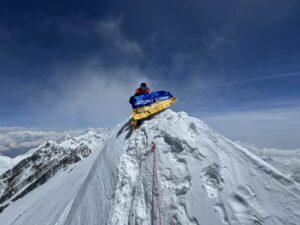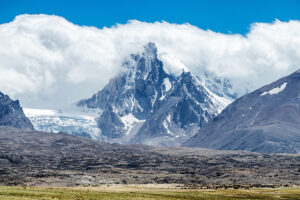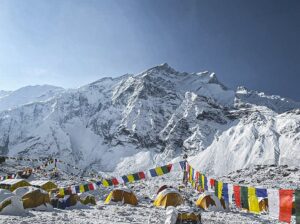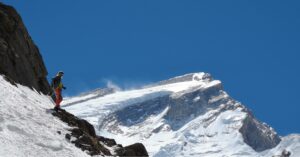Behind Stefi Troguet’s bright red lipstick and 100-watt smile is a serious athlete who loves the mountains
Stefi Troguet’s entree two years ago into high-altitude mountaineering showed how to blend a climbing career with 21st-century social media.
We first noticed her on a 2019 Instagram post, which showed a young woman in brightly colored tights and red lipstick — a most unusual sight in northern Pakistan. Her image and attitude raised eyebrows at first. Born in Andorra in the 1990s, she is a child of the new century and feels at ease on social media, but also had to fight comments about “being too colorfully dressed or showing too much flesh”.
Three weeks later, she showed her true colors — and her eternal red lipstick smile — by climbing Nanga Parbat in rather tough conditions while keeping pace with Sergi Mingote, Ali Sadpara, Cala Cimenti, and Nirmal Purja. Then last autumn, she shared a video dancing and singing on Manaslu’s final ridge, without O2.
“The feedback on social media eventually improved and now I feel I have a virtual family [there],” she says. And a fairly large one: 53,000 Instagram followers and 10,000 on Twitter. Not bad for a 28-year-old ski coach and mountain guide who has just started her career and who lives in a country the size of New Orleans.
This week, in an interview with ExplorersWeb, she reflects on what and how she wants to climb. In the short term, she is back for Dhaulagiri, Broad Peak, and K2, with no oxygen mask to cover her permanent, frost-proof, red-lipsticked smile. And she discusses the loss of most of her “mountain family”, who sadly perished this winter, on K2 and elsewhere.

In 2019, an all-too-relaxed Stefi Troguet joined Ali Sadpara in Skardu to climb Nanga Parbat…

….and some weeks later, battling a blizzard on Nanga Parbat.
Part of her talent is that she really is as bright, as giddy about mountains, and as friendly as she looks on the screen. During the lockdown, she gave a positive alternative to doomscrolling by sharing her training sessions on her flat’s rooftop. In Andorra, as in Spain, even short walks were forbidden for weeks.
As soon as restrictions eased, she ran to the Alps and climbed and skied virtually everything in her path, preparing to climb Broad Peak and K2 this summer.

Troguet ski touring in the mountains of her “pretty little country” of Andorra, as she describes it.
What Troguet hadn’t expected was losing to K2 many of the friends with whom she had summited her first 8,000er, including her “favorite soul” in Pakistan, Ali Sadpara.
“I am aware that accidents cannot be ruled out when climbing 8,000’ers,” she says. “Death and pain are cards in the deck we play with in the Himalaya, and I have spoken about it honestly with my family. But when I assume that danger, I was thinking of myself — not my friends! So I was totally in shocked when I heard about Sergi, then Cala [Cimenti, killed in an avalanche in the Alps], and anguished when Ali went missing.”
“Their loss hit me harder than I could have expected. For two weeks, I was unable to train or go out. I played over and over the videos that I had recorded from Nanga and Manaslu, especially those with Ali. He was like a second father to me.
“The relationships you build on expeditions are unique. I have many friends, especially a great group of girlfriends with whom I have grown up. I have traveled, I have lived… But while time in the mountains is brief, you bond with the people you live with so intensely, sharing everything, including very difficult circumstances. It was so hard!
“I got physically sick, I had difficulty breathing. First, I thought I had COVID so I took the tests, but doctors said it was anxiety. Eventually, I became able to watch the videos without bursting into tears and simply recalling the happy memories. Then I knew I was ready to move on.
“On the other hand, I felt I couldn’t just go to K2 after all that had happened. I needed something to clear my mind first, a progressive return to high altitude — another mountain. And then Jonathan García mentioned Dhaulagiri. So why not? The training is done and the mountain is there waiting. We’re leaving next week.
García, Alex Txikon’s partner on his attempt to climb Everest last winter, will team up with Troguet. “We’ve tuned up really well, despite not being able to train together through the winter,” she said. Although they both live in the Pyrenees, they have had to stay in their areas, Troguet in Andorra and García in Spain’s Benasque Valley.

Rather than a climbing mecca, Andorra is famous mainly for its ski resorts and its shopping, thanks to low taxes. “I grew up surrounded by mountains, so I really never noticed them as something extraordinary. From a very young age, my brother and I trained hard in downhill skiing and soon started competing,” Troguet recalled.
The culture shock came when she left home to go to college in Barcelona. “That is the dream of many Andorran youngsters, to go and study in the big city,” she said. “But I lasted two weeks. It was far too big for me. I simply packed and returned home, to my mom’s utter dismay.”
There was even more parental disappointment when Troguet decided not to go to college at all but instead became certified as a downhill and telemark instructor and trekking guide. She worked hard — “My only times off were Christmas and New Year’s Eve, but with the money I made that year, I traveled around the world.”
In that sense, she breaks the mold of wealthy children populating Himalayan base camps. “I self-financed my expedition to Nanga Parbat. Then I decided I wanted to go to Manaslu as well, so I sold my car — and you can’t imagine how much I loved that car, that was my grandfather’s inheritance! But I wanted Manaslu more.”
Her passion for mountaineering began at home in the Pyrenees, but soon her ambitions turned to the Seven Summits: Elbrus and Kilimanjaro. On a trek in Nepal, she climbed Mera Peak, then fell in love, as many do, with lovely Ama Dablam. To climb it, she trusted a young Nepali who had just started a guiding company called Elite Himalayan Adventures. His name was Nirmal Purja.

Stefi Troguet on Ama Dablam, above Camp 1, in 2018.
With Elite, she climbed Nanga Parbat, her first 8,000’er, in summer 2019. Her perma-smile in the pictures does not reflect the struggle. “It was very hard,” she said. “We spent the night in Camp 4, before the summit push, with six people crammed into a two-person tent. That’s an experience I do not recommend to anyone. I could really feel how it must have been on K2, with people jammed from the lack of tents in Camp 3.
“In my case, when the time came to set off toward the summit, I could barely move. Each step was torture and my poor acclimatization didn’t help. Somehow, I got moving, went higher, and finally, I saw myself on the top.” The video below documents Troguet’s Nanga Parbat expedition (in Catalan, with English subtitles).
On Manaslu, she experienced a more crowded mountain but reaffirmed her natural ability to acclimatize fast. On neither of her 8K summits has she used O2. She plans to continue in this style on the three 8,000m peaks this year.
On Dhaulagiri, she and Jonathan García will share Base Camp with an international all-female team and probably Spaniard Carlos Soria, now 82, still whaling away at the mountain he has attempted a dozen times.
“The paces will be surely different since we are the only ones climbing without O2,” she says. The pair will acclimatize by first trekking to Everest Base Camp — “You can get some altitude in a very comfortable way” — then trekking to Dhaulagiri as well. The other climbers will fly into Base Camp.
Troguet’s genuine enthusiasm for the mountains contrasts with the broad public perception of competition and drama. “I’d rather share the human side of climbing, the joy it brings to me, and how I live the experience,” she says.
She doesn’t dismiss the idea of climbing all 14 8,000’ers, but is in no hurry. “Right now, I am preparing for the three expeditions immediately ahead. Then we’ll see.”
She would use oxygen for emergencies in case of AMS, but not to climb, she says. “It’s about me and the mountain. If my body says I have to turn around, I will.”

Troguet singing and dancing near the summit of Manaslu.
Troguet hopes that the Dhaulagiri experience will help her to find the peace of mind she needs to face K2 later this summer. Nevertheless, she plans to spend as little time as possible on what the Baltis call Chogori.
“The plan is to acclimatize properly on Broad Peak, which is more accessible and hopefully less crowded,” she explains. “Of course, I’ll try to reach the summit [of Broad Peak]. However, the main plan is to head to K2 once acclimatized and launch a summit push as soon as conditions permit. We expect more people on that mountain, with increased risk of crowding and rockfall.”
She will fly to Pakistan on June 4 and expects to reach Base Camp a week later, which will put her ahead of most teams. However, she expects the route on K2 to be fixed by the time she arrives.
“K2 is looking more and more as Everest, and each year, one of the biggest teams is in charge of fixing the route asap and placing new ropes,” Troguet says. “The downside is that every year new ropes become entangled with several old ones, which is actually dangerous, as we have seen this past winter.”
She likes Sajid Sadpara’s plan to clean up the mountain and if she can be there during that project, she hopes to help. Finally, when asked how to keep a perfectly red smile on an 8,000 peak, she admits, “I retouch it from time to time. It all started as a coincidence but progressively it has become a sort of personal brand.”
She does not yet have a cosmetics sponsor but it wouldn’t be surprising if one comes knocking soon.






